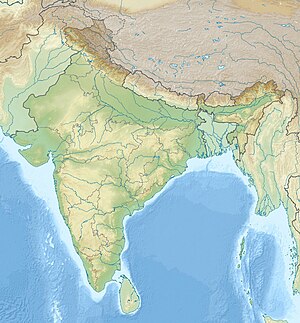The Yavanarajya inscription, also called the Maghera Well Stone Inscription,[2] was discovered in the village of Maghera, 17 kilometers north of Mathura, India in 1988.[3] The Sanskrit inscription, carved on a block of red sandstone, is dated to the 1st century BCE, and is currently located at the Mathura Museum in Mathura.[3][4] The inscription notes the donation of a water well and tank to the community in 1st century BCE, built by a Brahmana.[5]
| Yavanarajya inscription | |
|---|---|
Ancient Sanskrit inscription Mathura GMM 88.150 | |
| Material | red sandstone |
| Size | 102 x 37 centimeters |
| Writing | Sanskrit, Brahmi script[1] |
| Created | 1st Century BCE |
| Discovered | 1988, in Maghera, a village outside Mathura 27°34′16″N 77°35′24″E / 27.571171°N 77.590097°E |
| Place | Mathura, Uttar Pradesh |
| Present location | Mathura Museum, India |
The inscription was published and analysed by French indologist Gérard Fussman in 1993.[6] The inscription is in Brahmi script, and is significant because it mentions that it was made in Year 116 of the Yavanarajya ("Kingdom of the Yavanas"), and proves the existence of a "Yavana era" in ancient India.[7] It may mean that Mathura was a part of a Yavana dominion, probably Indo-Greek, at the time the inscription was created.[3]
Inscription edit
The Yavanarajya inscription is in Brahmi script and describes a dedication for a well and a tank in Mathura on "The last day of year 116 of Yavana dominion (Brahmi script: 𑀬𑀯𑀦𑀭𑀚𑁆𑀬 Yavanarajya)". Although the term "Yavanas" can sometimes mean "westerners" in general, inscriptions made at this early period generally use the term Yavana to refer to the Indo-Greeks, and known inscriptions referring to the Indo-Parthians or Indo-Scythians in Mathura never use the term Yavana.[3] The date mentioned on the stone was the Hindu festival day of Holi, according to the Hindu calendar.[3][8]
Date edit
The year 116 probably refers to the Yavana era (yonana vasaye), thought to begin in 186-185 BCE based on Bajaur reliquary inscription which gives an equivalence between the Yavana era and the Azes era.[9] The inscription would thus have a date of 70 or 69 BCE.[5][9] Some other authors have also suggested the date is counted in the Maues era (circa 80 BCE) or the Azes era (circa 57 BCE), but these have never been referred to as "Yavana era" in any other inscription.[3]
Harry Falk and others have suggested that the Yavana era actually started in 174 BCE, based on a reevaluation of the Azes era which is now thought to have started in 47/46 BCE. This reevaluation of the start of the Yavana era means that the Yavanarajya inscription dates to 58 BCE.[10]
Content edit
The Yavanarajya inscription, written in elegant Sanskrit, reads:[11]
| Translation (English) |
Transliteration (original Brahmi script) |
Inscription (Sanskrit in the Brahmi script) |
|---|---|---|
|
|
|
Interpretation edit
The Yavanarajya inscription, states Sonya Rhie Quintanilla, mentions year 116 of the yavana hegemony (yavanarajya), attesting to the 2nd-century and 1st-century BCE Indo-Greek presence. This makes the inscription unique in that it mentions the Indo-Greeks, and it "may confirm" the numismatic and literary evidence which suggests that Mathura was under the ruler of the Indo-Greeks during the period between 185 BCE-85 BCE.[12] It is unclear whether the Indo-Greeks were still present at the time the inscription was engraved, states Quintanilla. She states that the inscription's mention of a family of "Brahmin merchants" is significant as well and the foreign rule must have had a lasting impression on them.[5]
Quintanilla states that the nearly contemporaneous coinage of Menander I (165-135 BCE) and his successors found in the Mathura region, in combination with this inscription, suggests the hypothesis that there was a tributary style relationship between the Indo-Greek suzerains and the Mitra dynasty that ruled that region at the time.[5]
References edit
- ^ Gerhard Lüdtke; et al. (2009). Kurschners Deutscher Gelehrten-Kalender 2009, Vols 1-4. W. de Gruyter. p. 2766.
- ^ Goyal, Shankar (2004). India's ancient past. Book Enclave. p. 183. ISBN 9788181520012.
- ^ a b c d e f History of Early Stone Sculpture at Mathura: Ca. 150 BCE - 100 CE, Sonya Rhie Quintanilla, BRILL, 2007 pp. 254-255
- ^ "Some Newly Discovered Inscriptions from Mathura : The Meghera Well Stone Inscription of Yavanarajya Year 160 Recently a stone inscription was acquired in the Government Museum, Mathura." India's ancient past, Shankar Goyal Book Enclave, 2004, p.189
- ^ a b c d History of Early Stone Sculpture at Mathura: Ca. 150 BCE - 100 CE, Sonya Rhie Quintanilla, BRILL, 2007, p.8-10 [1]
- ^ "Ménandre l’Indo-grec ou Paul Demiéville revisité" Journal Asiatique 1993, 1-2, pages 61–138
- ^ Fussman, Gérard. The riddle of the ancient eras is not yet solved (PDF). p. 242.
- ^ Gérard Fussman (1993), "Ménandre l’Indo-grec ou Paul Demiéville revisité", Journal Asiatique, Volume 281, 1-2, pages 113-114
- ^ a b c d History of Early Stone Sculpture at Mathura: Ca. 150 BCE - 100 CE, Sonya Rhie Quintanilla, BRILL, 2007, p.255-256 [2]
- ^ Falk, Harry (2007). "Ancient Indian Eras: An Overview". Bulletin of the Asia Institute. 21: 136. JSTOR 24049367.
- ^ Published in "L'Indo-Grec Menandre ou Paul Demieville revisite," Journal Asiatique 281 (1993) p.113
- ^ Quintanilla, Sonya Rhie (2007). History of Early Stone Sculpture at Mathura: Ca. 150 BCE - 100 CE. BRILL. p. 9. ISBN 9789004155374.
